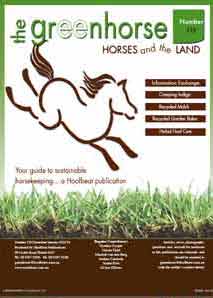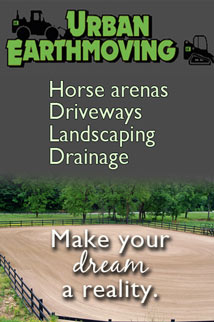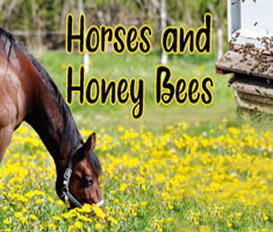The Green Horse section provides practical information on managing environmentally sustainable horse properties, readers stories and tips, as well as advice and articles from equestrian experts in their fields.
DECEMBER JANUARY 20/21
Vol 42 No 4
In this issue of The Green Horse you will find the following articles
KNOW YOUR PESTS- TERMITES.
protect your home and property by easily recognising termite signs.
by Rhiannon Brown - Envirapest
GATES THE HIDDEN DANGERS IN YOUR PADDOCKS by Liz Tollarzo
There is a need to know what gates are safest for your horse, and the various aspects of any dangers they may create for your horses.
RECYCLED MATERIALS FOR YOU AND YOUR HORSE
by Celine Bønnelykke
There are now solutions to help fight waste pollution through careful selection of competition or casual wear, horse gear and when purchasing your next horse rug.
THE KILL PILL e
Eradicating invasive trees.
BEFORE YOU SHOO THAT FLY
Why are our horses plagued by flies.
by Country Park Herbs
HORSES AND HONEY BEES -
Can they share space on the property?
by Wendy Elks
WIN A YEAR'S SUBSCRIPTION...
share your equine property management tips and each issue one reader will win.
Send ideas to -
The Green Horse Support <greenhorse@hoofbeats.com.au>


PREVIOUS ARTICLES
Available on line
Oct/Nov 20
SOLAR-POWERED PRODUCTS
by Celine Bønnelykke
In previous issues we have discussed the economics of setting up a solar-driven property, but if finances don’t stretch to installation of the whole package, there are ways to ease into the solar-world.
Aug/Sept 20 THE HIDDEN DANGERS IN OUR PADDOCK.
by Elizabeth Tollarzo
Horses love to run, play, buck and then run again and we often, through lack of risk assessment or management practices, place them in areas that are fraught with dangers.
JUNE JULY 20 GOING SOLAR ON THE HORSE PROPERTY Where to put your panels Part 2
Once you have selected what solar system best suits your needs, then you need to look at how you can maximise the advantages.
APRIL MAY 20 GOING SOLAR ON THE HORSE PROPERTY Part 2
Once you have selected what solar system best suits your needs, then you need to look at how you can maximise the advantages.
FEB/MARCH 20 ANTS AWAY
by Mark Brown Envirapest
So, what can you do to deter ants from your house and your stables??
DJ19/20 KEEPING SNAKES OUT OF THE STABLE by Wendy Elks
Snakes may be protected under Wildlife regulations in Australia, and they may be great for keeping the mice and rats down, but do we want to find them in our stables near our horses and pets?
ON19 - TERMITES- common myths
by Rhiannon Brown, Envirapest
Your house and stables are looking wonderful this spring, but do you know what is happening inside the walls of your brick or timber building?
AS19 - OUCH THAT HURTS
by Catherine Bird for Country Park Saddlery
The extent of the swelling is usually an indication of the severity of the infection or injury and the cause needs to be established before giving herbs.
JJ19 - MANAGING PASTURE
by Rhiannon Brown, Envirapest Healthy pasture means healthy horses.
A/M19 - STOP THOSE WEEDS
Property biosecurity
by Rhiannon Brown, Envirapest
Putting simple precautionary steps into place can make it tough for weeds to get a hold on your equine paradise.
|
  
  


by Wendy Elks
Some say that horses and honey bees don’t mix, but with costs associated with keeping horses rising all the time property owners are looking at options for an income stream to ‘supplement’ their equine lifestyle. Bees don’t take up a lot of room, and for a little effort the rewards can be sweet.
But can horses and a concentration of foraging, buzzing, and potentially stinging honey bees live in close proximity?
HORSES AND HONEY BEES
Bees operate side by side with people in cities and back yards, so is there any reason why they can’t exist on a horse property?
While they do co-exist, keeping the introduced European honey bee around horses does come with risk. The British Beekeepers’ Association (BBKA) states that “horses and bees don’t generally make good neighbours”. There have been a number of known cases of horses dying from bee stings.
In ‘Honeybees and Horses in Perfect Harmony’, entomologist Kristen Kovatch writes, “saying I can’t have honey bees because I have horses is like saying I can’t have roses because I have deer. As with most things, it all comes down to management.”
It’s essential to know what’s involved, before jumping in and stocking your property with hives. Joining a local club is a great way to learn. There are excellent online forums and many beekeepers are only too happy to share their knowledge and experience.
Bees can be kept for pollination purposes only, in which case very little management is required. Hives simply need checking periodically for pests (which may cause the bees to abscond) and bee health. If you wants honey, more boxes will be needed, so the bees can store enough to spare for humans to extract. Stored honey gets the hive through the colder months, so plenty must be left for them.
Placement is important
Hives placed along farm edges in a shelter belt ensures protection from curious, scratching horses, and the horses are protected too. Choose the highest point of land possible, so the bees are flying above people and animals. They leave and return to their hive on a regular flight path and in a straight line, so the entrance should face an open area.
Like horses, management of bees is an important aspect of keeping them healthy and happy.
Position hives to receive morning sun, with afternoon shade during summer. Bees regulate hive temperature at around 30 degrees all year round, but temperatures over 40 degrees may kill them without sufficient shade. In colder areas, avoid opening hives during winter, as the bees may be unable to raise the temperature again, and die of cold.
What’s the sting in keeping bees?
Honey bees sting to protect their hives containing honey, brood, workers and, most importantly, the queen. They may also sting if they feel threatened. In most instances a bee sting doesn’t pose a significant problem. But if you or a horse is known to be allergic to bee venom it’s necessary to know what to do.
Bee stings can happen anywhere; for horses, it may happen through grazing flowering pastures.
This can occur whether you have bee hives or not, as bees forage up to five kilometres from the hive.
For some horses a sting to the head, eyelids, muzzle and neck can be serious, even life threatening. The first time a horse is stung it’s usually a mild reaction at the sting site; there may be a welt and the sting area feels warm: this is because the body develops antibodies against the venom. It’s the second time, and thereafter, that venom becomes dangerous.
If you have a horse that reacts to bee stings then it is recommended you contact your veterinarian immediately if it’s bitten.
Bee friendly
A less hands-on option to keeping one’s own beehives is hosting somebody else’s. Allowing a beekeeper to keep hives on the property means plenty of pollinators on hand for fruit trees, vegetables, crops and paddock plants, without the responsibility of tending hives. Provided there’s a solid understanding of what’s expected and required for all parties (host, beekeeper, bees and horses), this can be a great way to learn before committing to having hives of your own.
Native Bees
The best way to enjoy bees with no adverse impacts on the environment or risk to you or your horse, is also the easiest approach: encourage native bees. Australia has approximately 2,000 species of native bees, and with recreational beekeeping on the rise and professional pollinating services transporting large quantities of honey bees to forests, commercial orchards and monoculture farms, local native bee populations can get pushed out.
To support native pollinators, go native in your plant selection and leave some natural bushland on your property, which has added benefits for biodiversity as a host of Australian native plants like Eucalyptus, Melaleuca, Angothora, Syzigium, Callistemon and Corymbia will bring the bees in buzzing!
Pollinators
All bee species are important pollinators .Native hives (unlike the honey bees) may not produce enough honey to share much with humans, but that’s not their purpose. They play a vital role in the ecosystem, so helping them is an important contribution to the maintenance of local species, and to general biodiversity.
While many horse owners keep bees and horses in close proximity without any problems, there is no guarantee that this will always be the case.
Plan well, seek advice from experts and consider the options carefully. Bees can get moody too, and en masse it can be terrifying, and dangerous.
Beekeepers comments on their experiences with bees and horses.
Belinda Noble
I have a hive in a tree belt between paddocks. The horses can and do stand within three metres of the hive... Even my most ‘orally fixated’ horse leaves the hives alone. I have had the hives there for coming up four years now.
Kyle Middleton
Kyle comes from Eleebana in NSW and became interested in bees when a swarm landed on a possum box on the family block. Kyle’s mum, a lifelong horse owner and riding coach, was okay with him keeping several hives on their one hectare horse property.
While there hasn’t been any issues in four years (“it would appear that the horses understand the boundaries with the bees”), Kyle advises keeping bees away from the horses. His are in a treed area where the grass is poor anyway, and there’s shade. A curious yearling was stung once, and thereafter kept its distance.
Sophie Warren
Horse trainer Sophie Warren of Sustainable Equitation at Herne Hill in WA keeps both.
“I got into bee keeping through my dad who took it up as a hobby a year prior to me. I loved the idea of doing it as something good for the environment - but like horses, you never stop at one hive and next thing I knew I had seven!
As a horse trainer I am always on properties fairly intensively stocked with horses but I’ve never had any troubles with horses interfering with the hives, even when they’ve been kept in the same paddock as the horses. I do always ensure the horses are not too close by when I am inspecting or working with the hives as I feel this helps to decrease the risk of a horse being stung.
Having access to your own raw honey is fantastic for wounds, and it makes a lovely Christmas gift for clients!” |